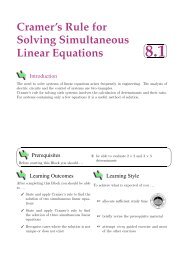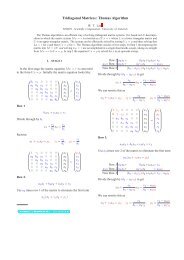Student Notes To Accompany MS4214: STATISTICAL INFERENCE
Student Notes To Accompany MS4214: STATISTICAL INFERENCE
Student Notes To Accompany MS4214: STATISTICAL INFERENCE
Create successful ePaper yourself
Turn your PDF publications into a flip-book with our unique Google optimized e-Paper software.
hence<br />
E( √ � ∞ √ 1<br />
Z) = z<br />
2Γ(1) e−z/2dz = 23/2Γ(3/2) 2Γ(1) = � π/2 ,<br />
0<br />
hence ˜σ = 2ˆσ/ √ π is unbiased for σ. If we let d = (n − 1) we similarly find for<br />
general n that<br />
E( √ � ∞ √<br />
Z) = z<br />
so<br />
0<br />
zd/2−1 2d/2Γ(d/2) e−z/2dz = 2(d+1)/2Γ((d + 1)/2)<br />
2d/2Γ(d/2) c =<br />
makes cS an unbiased estimator of σ.<br />
√ dΓ(d/2)<br />
√ 2Γ([d + 1]/2)<br />
7. First of all c(θ) −1 = � ∞<br />
0 x2 e −θx dx = Γ(3)/θ 3 = 2/θ 3 . Next, we get E( ˜ θ) =<br />
E(2/X) = θ 3 � ∞<br />
0 xe−θx dx = θ 3 θ −2 Γ(2) = θ and so ˜ θ is an unbiased estimator of θ.<br />
<strong>To</strong> get the variance we use E( ˜ θ 2 ) = 2θ 3 � ∞<br />
0 e−θx dx = 2θ 2 so Var( ˜ θ) = 2θ 2 −θ 2 = θ 2 .<br />
<strong>To</strong> find the Fisher information for θ, we first calculate ∂ ln f(x|θ) = −x + 3/θ,<br />
∂θ<br />
and then calculate − ∂2<br />
∂θ2 ln f(x|θ) = 3/θ2 . Thus eff( ˜ θ) = θ2 /(3θ2 ) = 1<br />
3 .<br />
E(ˆµ) = θ3<br />
6<br />
� ∞<br />
0 x3e−θxdx = θ3Γ(4) 6θ4 = 1/θ = µ so ˆµ is an unbiased estimator of µ.<br />
Similarly E(ˆµ 2 ) = θ3<br />
18<br />
� ∞<br />
0 x4 e −θx dx = θ3 Γ(5)<br />
θ 5 = 4<br />
3θ 2 so Var(ˆµ) = 1<br />
3θ 2 . <strong>To</strong> calculate<br />
the CRLB we find for g(θ) = 1/θ that g ′ (θ) = −θ −2 so the lower bound is<br />
I(θ) −1 {g ′ (θ) 2 } = θ2<br />
3 θ−4 = 1<br />
= Var(ˆµ).<br />
3θ2 8. The formal definition of a sufficient statistic (S) is that the conditional distribu-<br />
tion of the sample X = (X1, X2, . . . , Xn) given the value of S, that is knowing<br />
that S = s, does not depend on θ.<br />
If f(x|θ) is the joint distribution of the sample X, the statistic S is sufficient for<br />
θ if and only if there exists function g(s|θ) and h(x) such that, for all sample<br />
points {xi} and all θ, the density factorises f(x|θ) = g(s|θ)h(x).<br />
f(x|θ) =<br />
n�<br />
x<br />
i=1<br />
θ−1<br />
i e−xi {Γ(θ)} n<br />
= exp[(θ − 1) � ln(xi)]<br />
{Γ(θ)} n<br />
× e − � xi<br />
↑ ↑<br />
�� �<br />
g ln(xi)|θ h(x)<br />
Thus, by the factorisation theorem, S = n�<br />
ln(Xi) is sufficient for θ.<br />
47<br />
i=1<br />
,






